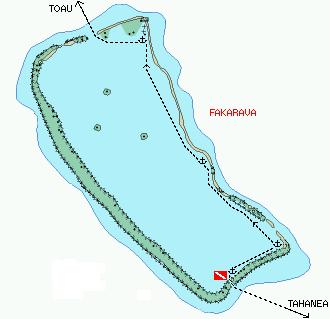
Click the map for an overview of the Tuamotus
|
Pacific Landfalls Fr. Polynesia Pages Related Pages |
Fakarava
 Click the map for an overview of the Tuamotus |
Language: Tuamotian, French
Population: About 450 Polynesians and French, living mostly by the
northern pass in the village of Rotoava.
Money: French Polynesian Franc
Landscape: Coral atoll: a ring of low coral islands (motus)
encircling a lagoon 37 miles X 25 miles.
History: The history of all the Tuamotu Islands is found on the
Tuamotu map page.
Visited: July 25-August 2, 2003
Read about diving in Fakarava!
Also, check out the newsletter
we sent out while we were in Fakarava!
(Sue) We entered Fakarava via the magnificent southern pass, called Tumakohua Pass. Several decades ago this was the cultural, social and political center of the Tuamotus, but all that remains today are ruins of the administration buildings, a prison, and a small church built from coral in 1862.
 Entering the southern pass, past the small dive resort |
There are couple small resorts here, now, with a dive shop. the biggest surprise
here was the profusion of small sharks that clustered around the yachts, just
like reef fish, swarming near when food crumbs were thrown onto the water. these
were 4 or 5 foot black tipped sharks, with lovely tan bodies. They completely
ignored us when we went swimming. The pass diving is out of this world: with
lovely coral, dozens of big sharks, and millions of fish. We were lucky enough
to get to borrow scuba gear from other cruising boats and take some dives while
others drifted above the divers. This time we dragged a small floating ball so
the dinghy crew could keep track of the divers!
We sailed up the eastern shore of the atoll and sent a few days alone off some
vacation houses where we found domestic (but un-penned) pigs snuffling along the
beach. Apparently if you whack open a coconut they go crazy for the fresh
coconut meat!
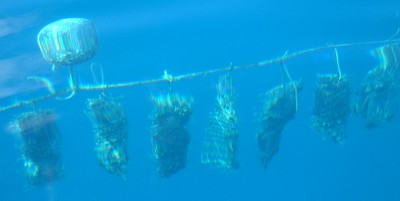 Nets of pearl oysters hang on long lines in the clear water |
At the northern end we navigated around and sometimes through massive pearl
farms (marked by buoys with ropes between them from which the pearl nets hang.)
The July Heiva Festival for all the Tuamotus was happening in Rotoava village
from July 29 to Aug 2 and we saw most of it. Much more sophisticated than the
Makemo dancing, the festival attracted competitors from 15 atolls who danced in
full costume and large dance troops under a big enclosure every night.
During the day we got to watch fruit races (men carrying 30 kilos of coconuts on
shoulder sticks, who ran barefoot over the coral roads), and copra contests in
which the men shuck coconuts and dig out the meat just as they do to prepare the
copra for sale. There were tables of seashell jewelry for sale, and
demonstrations of "tressage" or palm frond weaving. Our favorite was probably
the "Javelot" where the men threw hand-hewn spears at a coconut suspended on a
50-ft-high pole (15 m).
 Finding the gonad sack inside the shell. The mantle is the dark fleshy rim. |
We got to tour a pearl farm and hear all about the seeding of the pearls (done by men from China) with seed pearls from the Mississippi River. Each one is a sphere about the size of a pencil eraser, and covered in a yellow antibacterial agent to help reduce the risk of rejection by the live oyster. To create the "black" (really any color other than white) color of the pearls, a tiny slice of the mantle (like the lips) of another oyster is put in with the seed pearl. Once the oyster is seeded and hung in the lagoon in its net, if it rejects either the seed or the mantle it is tossed aside. The oysters are brought up every few months and carefully scrubbed and cleaned, then re-netted and hung again. The standard time to allow pearls to grow used to be 2 to 3 years, but now the pearls are harvested in less than 2 years. Consequently the quality of Tahitian pearls has decreased over the years. The older pearls used to have 1.5 mm of nacre (what we consider "pearl" around the seed), but now an acceptable pearl need have only 0.8 mm of nacre. This thickness is determined by x-ray once the pearls are sold to the wholesalers in Tahiti. Odd shaped pearls, often with strange lusters, are called "keshi" and have become more valuable in recent years. Tahitian black pearls are very high priced: all due to artificially raised prices and control of the supply.
 A large "keshi" - still a pearl, but misshapen |
(Amanda)
In Fakarava, I did my first dive since Bonaire and my certification, which
was exciting with sharks around us in the southeastern pass of Fakarava. We got
started a bit late though, resulting in a very slack or even slightly outward
tide, which made it a bit of a struggle to get back in. But we had a float on
top, and the only untoward happening was Chris's burst hose which resulted in a
fountain of bubbles appearing on top, followed shortly by a very confused
Christopher.
The highlight of Fakarava was really the festival, though a lot of it was
standing around in the hot sun waiting for things to happen. Javelot was a very
interesting one, along with the fruit carry - which sort of turned into coconut
carry. There was copra-preparing, which was interesting if slightly dull, along
with palm-frond weaving. And then the dancing. There was dancing on all four
nights of the fet, and finally we were able to see some more of the
Marquesian haka-style, warlike dancing, rather than the more typical things we
were seeing in the other islands. All the dances was probably my favorite part
of the festival.
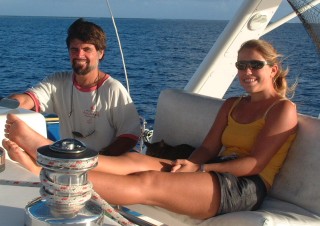 Glorious Tuamotu sailing! Inside the lagoon |
(Jon) Fakarava was one of my favorite atolls. In the south end, we did some excellent diving (both snorkeling and scuba), saw lots of sharks, and made some new cruising friends. Then we cruised the pristine northeast shore, exploring with our friends on Mariposa. In the village on the north end we learned a lot about pearl oysters and pearl farming, did some more snorkeling, found some pearl oysters we could harvest, and saw some wonderful cultural events (that were originally planned for French President Jacques Chirac).
 We usually have someone up the mast when navigating an atoll's inner lagoon |
We had a rollicking good sail from Tahanea with our friends on the Swan 57 Cowrie
Dancer. We had to have faith in our GPS as the southern entrance pass into
Fakarava leads almost due north, and we couldn't see it until we were less than
a mile away.
It really makes me wonder how cruisers navigated around this
area before GPS. Even the $1,600 Satellite Navigator (based on the Navy's
Transit system) that we had on
Oriental Lady would have had trouble.
We had a strange shock when we anchored that first day: We were by far the
smallest cruising boat! Our 45' is about average for US boats (and on the
large side for European boats) but our company for the first few nights were 2
Swans (a very expensive and luxurious brand of monohull) of 57' and 60', and a
custom designed 60 footer. Luckily, they all had extra scuba equipment,
and were not above loaning it out, so we did some very nice dives there,
drifting through the pass with the incoming current, and watching the several
dozen sharks that were waiting for dinner to come to them.
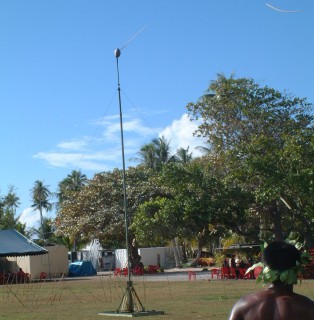 Few spears hit the coconut, so a forest of them would form opposite the pole |
(Chris) I really enjoyed our stay in Fakarava. We went on several
dives through really nice passes in the reef, and enjoyed the festival in town. As my dad
mentioned, several other cruisers loaned us gear, and there were lots of great
sights underwater. There weren't many kids on the the other boats, and those
were much younger than me, but the cruising community is always nice to be with.
On the other hand, spending some time in the town and seeing the local
celebrations was really great. Watching the basket weaving and coconut shelling
was interesting, but didn't really hold my interest. The outrigger canoe races
were fun to watch, though we couldn't see very much of them. The javelin
throwing and dancing were definitely the coolest things to see. The javelins
were really spears, about six feet long, with an eight inch steel blade on the
end. They were thrown at a target consisting of a coconut in its husk (about the
size of a person's head) stuck on the top of a vertical 15 meter (50 foot) pole.
The men were standing on the edge of a circle with perhaps an 80 foot radius,
and although only a few of the spears would hit in any particular volley, most
of them would come pretty close. The far side of the circle (the throwers stood
first on one side, then the other) became a forest of upright spears from more than
100 missed throws. I could easily imagine a tribal battle, in which these spears
would be the opening volleys, with the spearmen falling back as the enemy
charged across the field... they would have been a formidable weapon.
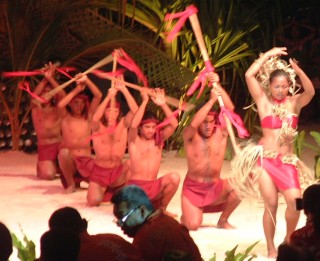 Both the synchronized groups and the talented solo dancers were fun to watch |
The dancing was undoubtedly the most fun thing to watch on Fakarava. The style of the groups was interesting; although they often danced in the same dances, there was almost no interaction between men and women, or any of the dancers. Most groups performed very similar dances in mixed-gender groups of 15 to 30 young people, but I personally really liked the soloists, because they gave a chance to really appreciate just how amazing these peoples' movements were. It was absolutely unbelievable how graceful and flexible they were! Apparently several islands have schools devoted to learning these dances, which involve the men stepping and stamping, and the women wiggling their hips, while doing completely different motions with their upper bodies. I can't adequately describe it in writing, but the sight was well worth seeing.
Fakarava Newsletter | Fakarava Diving | Marquesas Letters | Tuamotus Letters | FP Flora & Fauna
Top Level: Home | Destinations | Cruising Info | Underwater | Boat Guests | Ocelot | Sue | Jon | Amanda | Chris | Site Map | Make a Comment
|
If our information is useful, you can help by making a donation |
Copyright © 2000‑ Contact: Jon and Sue Hacking -- HackingFamily.com, svOcelot.com. All rights reserved.